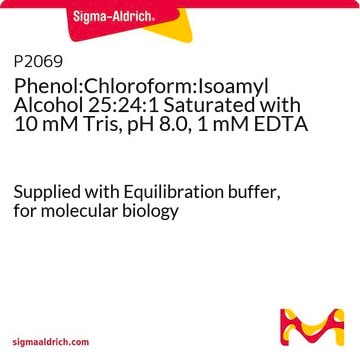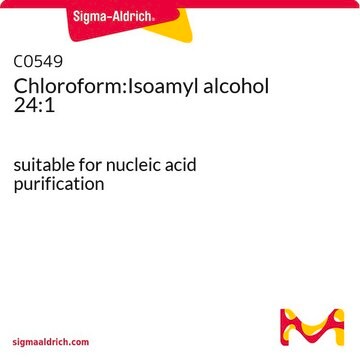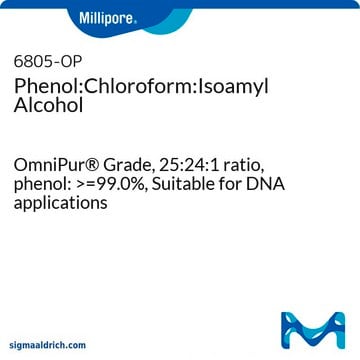P2069 is P3803 supplied with an equilibration buffer. Equilibration buffer B5658-1EA is required for DNA extraction.
P3803
Fenol:cloroformo:alcohol isoamílico 25:24:1, saturado con TRIS 10 mM, pH 8,0, EDTA 1 mM
for molecular biology
Sinónimos:
DNA extraction
About This Item
Productos recomendados
grado
for molecular biology
Ensayo
≥99.0%
Formulario
liquid
pH
6.5-6.9(pH of phenolic phase)
aplicaciones
agriculture
temp. de almacenamiento
2-8°C
Aplicación
Advertencia
Otras notas
Productos recomendados
Producto relacionado
Palabra de señalización
Danger
Frases de peligro
Consejos de prudencia
Clasificaciones de peligro
Acute Tox. 3 Oral - Acute Tox. 4 Dermal - Acute Tox. 4 Inhalation - Aquatic Chronic 2 - Carc. 2 - Eye Dam. 1 - Muta. 2 - Repr. 2 - Skin Corr. 1B - STOT RE 1 Oral - STOT RE 2 - STOT SE 3
Órganos de actuación
Central nervous system, Liver,Kidney, Nervous system,Kidney,Liver,Skin
Código de clase de almacenamiento
6.1A - Combustible acute toxic Cat. 1 and 2 / very toxic hazardous materials
Clase de riesgo para el agua (WGK)
WGK 3
Punto de inflamabilidad (°F)
Not applicable
Punto de inflamabilidad (°C)
Not applicable
Elija entre una de las versiones más recientes:
¿Ya tiene este producto?
Encuentre la documentación para los productos que ha comprado recientemente en la Biblioteca de documentos.
Los clientes también vieron
-
Hello, I have used in the past P2069, which needs the equilibration buffer for pH8. Does P3803 also need the same equilibration buffer B5658-1EA? Thank you!
1 answer-
Helpful?
-
-
I received two bottles. One for the phenol and one for the buffer. Do I need to add the phenol to the buffer? or the buffer already contains the phenol?
1 answer-
Yes, the equilibration buffer is to be added before use, according to the following instructions:
Add the entire contents of the small bottle of Equilibration Buffer to the large bottle of Phenol:Chloroform:Isoamyl Alcohol reagent.
Mix gently and allow the phases to separate before use, typically 2–4 hours.
This will adjust the pH of the phenol phase from pH 6.7±0.2 to 8.0±0.2.Please see the link below to review the product datasheet for additional information:
https://www.sigmaaldrich.com/deepweb/assets/sigmaaldrich/product/documents/490/315/p3803pis.pdfHelpful?
-
-
What is the Department of Transportation shipping information for this product?
1 answer-
Transportation information can be found in Section 14 of the product's (M)SDS.To access the shipping information for this material, use the link on the product detail page for the product.
Helpful?
-
-
I see that you list two equilibrated Phenol:Chloroform:Isoamyl alcohol products. When should I use Product P3803, and when should I use Product P2069?
1 answer-
In short, P3803 is for RNA work, and P2069 is for DNA work. Product P2069 consists of one bottle of Product P3803 and one bottle of Product B5658. The B5658 is added to the P3803 to raise the pH of the organic phase from 6.7 to 8.0; pH 8.0 is not suitable for RNA work, because RNA can degrade at the higher pH.
Helpful?
-
Active Filters
Nuestro equipo de científicos tiene experiencia en todas las áreas de investigación: Ciencias de la vida, Ciencia de los materiales, Síntesis química, Cromatografía, Analítica y muchas otras.
Póngase en contacto con el Servicio técnico












